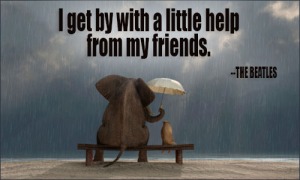Blog #218~Special Needs Parents, What We Need From A Friend
Parenting a child with special needs can be lonely. Having a support system is crucial to maintain a positive well-being. Uncomfortable situations, surrounded by raising a child with special needs, make it difficult for people to know how to help as a friend. My son Nick is 24 years old and has a dual diagnosis of Down syndrome and autism. My close friends keep me sane, make me laugh and understand what I go through. As a parent of a child with special needs, here is what we need from a friend.

We need a friend to understand. Parenting a child with special needs is a constant battle with schools, doctors, insurance companies, and daily behavior challenges at home. Add sleep deprivation to the mix, and you have one cranky parent at times. Imagine starting your day off, washing sheets and cleaning excrement off the wall and carpet of your child’s bedroom. In this code brown emergency, your child goes downstairs and dumps out your freshly brewed coffee all over the kitchen floor. This is a page out of my story some 15 years ago. It’s the story of so many parents dealing a child who has Down syndrome and/or autism. We rely on our friends to listen without judgement, and to understand the pressure and challenges we deal with everyday. The best of friends, roll up their sleeves and pitch in.

One vacation in New Braunfels, Texas, my son got hold of my make up bag and made a huge Picasso mess on the bed sheets in the rental house we shared with friends. My friend Sally, poured us a glass of wine, and jumped right in scrubbing the stains with me as we laughed at the absurdity of the moment.
A good friend, says “Tell me what I can do” instead of “Call me if you need help”.
As special needs parents, we need our friends to listen and understand that sometimes our world is so complicated, that we may have to decline invitations or cancel at the last-minute. But please, don’t stop inviting us, sometimes we just need more lead time in order to secure a caregiver for our child. Other times, our child may be having a bad day or meltdown and we just can’t get out of the house.

As a parent of a child with special needs, we also crave normal conversations. Sometimes we are stuck at home, with our kids. Please, don’t worry so much about us being too busy. A simple text goes a long way, as does dropping by for a cup of coffee or glass of wine. Honestly, when I can focus on my friends problems and help them out, it makes me forget my own and feel much better. I treasure the moments with my friends, when we can dish about everyday life and share a few laughs together. Every Thursday, we power walking together. We vent, cuss, laugh and have normal girl talk. It restores our sanity! 🙂

A parent of a child with special needs, relies on friends that stand with us! They listen, understand and share together with us. We can’t do it alone, and our friendships sustain and keep us strong. That’s what is in my noggin this week.
~Teresa 🙂
Follow Nick:
Facebook and Pinterest @Down Syndrome With A Slice Of Autism
Instagram @nickdsautism
Twitter @tjunnerstall





